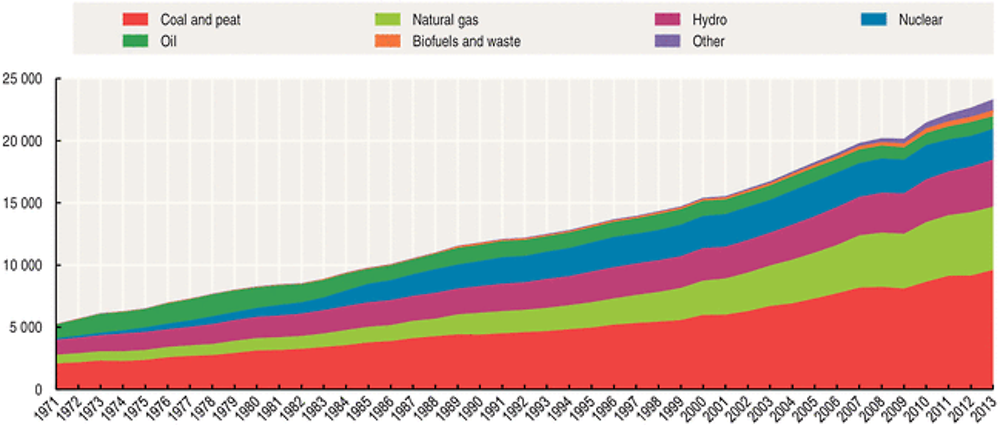Electricity generation
The amount of electricity generated by a country, and the breakdown of that production by type of fuel, reflects the natural resources, imported energy, national policies on security of energy supply, population size, electrification rate as well as the stage of development and rate of growth of the economy in each country.
Definition
Electricity generation includes fossil fuels, nuclear, hydro (excluding pumped storage), geothermal, solar, biofuels, etc. It includes electricity produced in electricity-only plants and in combined heat and power plants. Both main activity producer and autoproducer plants are included, where data are available. Main activity producers generate electricity for sale to third parties as their primary activity. Autoproducers generate electricity wholly or partly for their own use as an activity which supports their primary activity. Both types of plants may be privately or publicly owned.
Electricity generation is measured in terawatt hours, which expresses the generation of 1 terawatt (1012 watts) of electricity for one hour.
Comparability
Some countries, both OECD member and non-member countries, have trouble reporting electricity generation from autoproducer plants. In some non-member countries it is also difficult to obtain information on electricity generated by biofuels and waste. For example, electricity generated from waste biofuel in sugar refining remains largely unreported in a number of countries.
World electricity generation rose at an average annual rate of 3.6% from 1971 to 2013, greater than the 2.2% growth in total primary energy supply. This increase was largely due to more electrical appliances, the development of electrical heating in several developed countries and of rural electrification programmes in developing countries.
The share of electricity production from fossil fuels has gradually fallen, from 74% in 1971 to 67% in 2013. This decrease was due to a progressive move away from oil, which fell from 21% to 4%.
Oil for world electricity generation has been displaced in particular by dramatic growth in nuclear electricity generation, which rose from 2% in 1971 to 18% in 1996. However, the share of nuclear has been falling steadily since then and represented 11% in 2013.
The share of coal remained stable, at 40-41%, while that of natural gas increased from 13% in 1971 to 22% in 2013. The share of hydro-electricity decreased from 23% to 16% over the same time range.
Due to large development programmes in several OECD countries, the share of new and renewable energies, such as solar, wind, geothermal, biofuels and waste increased. However, these energy forms remain of limited importance: in 2013, they accounted for only around 6% of total electricity production for the world as a whole.
Sources
-
International Energy Agency (IEA) (2015), Energy Balances of OECD Countries, IEA, Paris.
-
IEA (2015), Energy Balances of Non-OECD Countries, IEA, Paris.
Further information
Analytical publications
-
IEA (2015), World Energy Outlook, IEA, Paris.
-
IEA (2013), Electricity and a Climate-Constrained World, Data and Analyses, IEA, Paris.
-
OECD (2015), Aligning Policies for a Low-carbon Economy, OECD Publishing.
-
OECD (2013), Inventory of Estimated Budgetary Support and Tax Expenditures for Fossil Fuels 2013, OECD Publishing.
-
OECD (2013), Taxing Energy Use, A Graphical Analysis, OECD Publishing.
-
Cooke, D. (2011), “Empowering Customer Choice in Electricity Markets”, IEA Energy Papers, No. 2011/13.
Online databases
Websites
-
International Energy Agency, www.iea.org.

